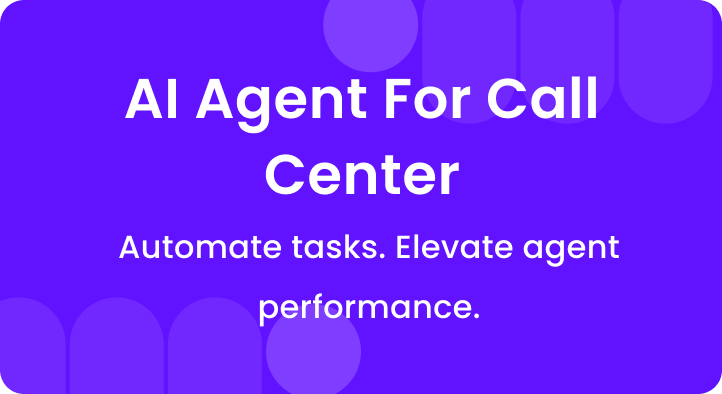Think!
Think beyond delivering just a service.
Address incoming queries with tangible solutions, minimize dissatisfaction and maximize efficiency.
That’s how you stay competitive in the battleground called Customer Experience (CX).
However, many companies have still not woken up to the reality that poor CX is eating their revenue and impacting their Net Promoter Score.
For sure, there’s a disparity between customers’ expectations and the business’s strategy.
In 2021, approx 49% of consumers abandoned the brands due to poor customer experience.
A poor customer experience often turns into a mindset that xyz company do not provide a good customer service.
That happens when businesses collect data but don’t put it to actionable use to make landmark decisions.
Most services, especially those in a direct customer-facing vertical such as the contact centers, lack the needed education about the importance of measuring customer loyalty & outlook.
In this discussion, we explain the meaning and ways to improve NPS (Net Promoter Score/System), strategies & their prolonged impact on the customer-business association.
Table of Contents
A. What is Net Promoter score (NPS)?
Net Promoter Score is an index that measures customer satisfaction and furthers their loyalty in return for the service.
It’s like a 5-star rating system but with a broader scope to evaluate your customer’s opinion and intent.
This means, it evaluates a customer’s likelihood to re-subscribe and refer to more users.
While 0 to 10 is the most popular scale, brands have been customizing it for -100 to 100+ as per strategy.
NPS score is not a one-time measurement, it’s an ongoing process.
It’s important to keep track and improve NPS score over time, to see if there is a trend and identify any issues that need to be addressed.
It’s also important to use NPS in combination with other customer satisfaction metrics, to get a more complete picture of customer loyalty and satisfaction.
B. How to improve NPS?
Here are the 10 certain ways to accomplish this goal.
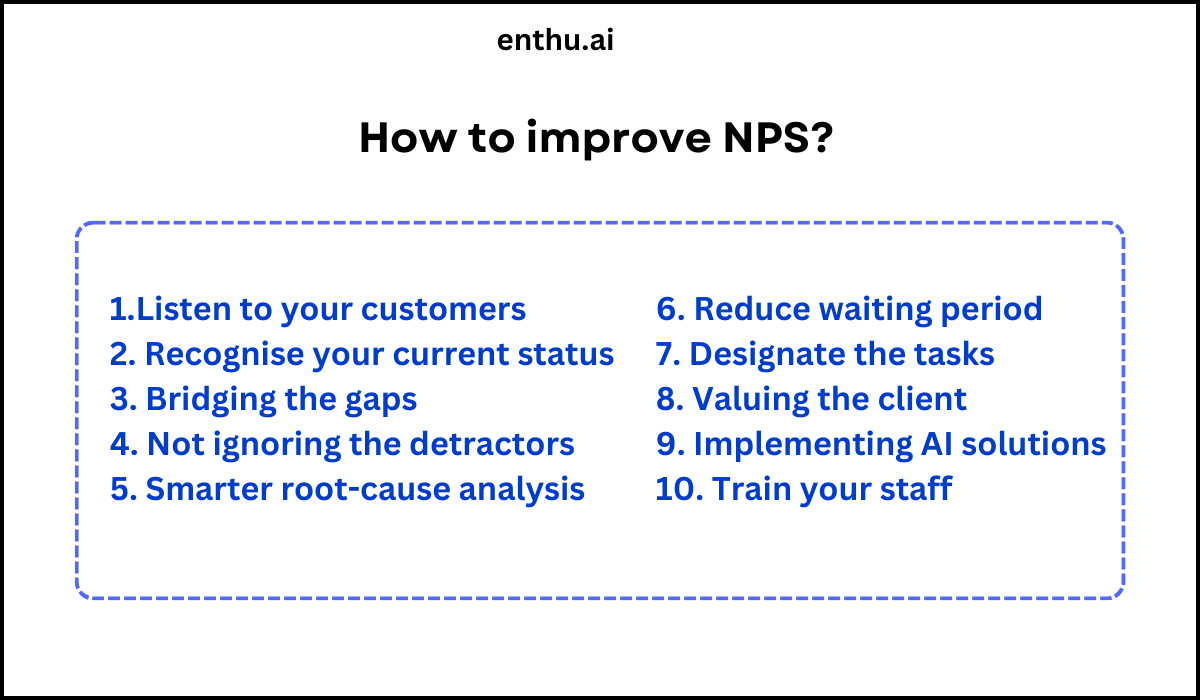
1. Listen to your customers
Listening your customers is one of the best way to improve NPS (net promoter score).
Businesses can gather feedback about their products and services, identify pain points, and understand what customers like and dislike about their offerings.
This information can be used to make informed decisions about how to improve the customer experience, which can lead to higher NPS scores.

For example, if customers consistently complain about long wait times when contacting customer support, a business can take steps to reduce wait times and improve the overall support experience.
Moreover, businesses identify areas of their product or service that are performing well.
This information can be used to reinforce positive customer experiences and reduces customer churning.
2. Recognising your current status
The initial step is to comprehend the existing state of your NPS program for this self-introspection.
Next, know how far you are getting the benefit of the feedback given by the consumers, sometimes this feedback is not even noticed thus the efforts made in calling and asking for their feedback prove unworthy.
Cover all vital points in the survey form and feedback formats and they are not confusing at all and thus helps to improve NPS.
3. Bridging the gaps
From top to bottom, include everyone in the exercise.
Ensure that the NPS earns participation from all levels, from top management to employees at the bottom of the hierarchy.
Set the training for agents as per the findings from the NPS.
To ensure optimal returns from the effort, circulate the findings to everyone including sales.

The customer care executives should also be a vital part to improve NPS and they must be encouraged by revealing that they are performing well and contributing constructively to the growth.
A chain of events occurring like receiving the feedback, connecting with the sales team, and even involvement of top management and front desk executives in the process is important.
4. Not ignoring the detractors
If you intend to have an NPS analysis then a major factor knows the reasons for low marking given by the consumers.
Promoters are the customers with rating 9 or 10; a 7 to 8 rating goes for the Passives while a 0 to 6 rating essentially reveals that they are the Detractors.
Comprehending the problems of detractors and improving them can help businesses grow tremendously.
So ignoring the detractors is injurious to the health of a business.
5. Smarter root-cause analysis
As discussed in the beginning, most companies collect big data but don’t have the expertise to put it to actionable use.
An Net promoter score campaign may attract a diverse range of feedback on different questions from different types of customers.
Usually, this makes it difficult for businesses to consume the right data simply because they have too much of it.
AI can help here by instantly filtering the most important issues.

Enthu.AI for example consumes machine learning expertise to crawl through big data generated from the campaign and ultimately group the most important concerns.
This is a great hack to forward valuable feed to the trainers and their agents.
6. Kill the waiting period to avoid negative NPS ratings
Most often in call centres, there is a long queue of consumers, who are waiting to get their problems sorted out, this might annoy them and can negatively affect the feedback system.
So the most avoidable thing is to keep them waiting and transferring calls unnecessarily to multiple departments.
Businesses are required to perform introspection and find ways to repair the flaws.
7. Designate the task well to strengthen NPS
Designation of the tasks effectively to varied departments makes the whole method more interesting but integrating the main outcome is also an essential task.
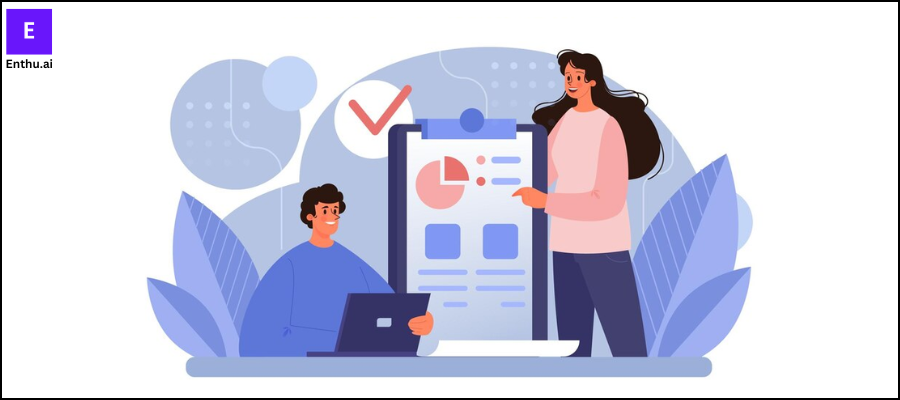
Integrate various departments with one goal and they must be effectively given and trained for their tasks.
This will no doubt improve NPS scoring and obtain the dividend.
8. Valuing the client
Consistency in providing solutions and achieving CSAT which is the contentment of the client is the main aim to improve NPS system, thus the practical targeting is done as an initial step then setting benchmarks and reducing the response time.
Moreover, the intervals between sending surveys must not be too long or shorter and they must reach the persons who are using the products or services and the channels should be apt.
9. Implementing AI solutions
AI can improve NPS by optimizing the customer journey.
By using AI to analyze customer feedback, businesses can identify pain points in the customer journey and take steps to address them.
For example, if customers consistently abandon their shopping carts at the payment stage, AI can be used to identify the reasons for abandonment and suggest improvements to the payment process.

This can lead to a smoother customer journey, higher customer satisfaction, and ultimately, higher NPS scores.
Finally, AI provides proactive customer support by predicting and preventing issues before they occur.
For example, a utility company can use AI to analyze customer data and identify customers who are likely to experience an outage.
The company can then proactively contact these customers and provide information on how to avoid the outage or minimize its impact.
10. Train your staff
Training staff can improve NPS is by ensuring that employees have the knowledge needed to provide accurate and helpful information to customers.
For example, in a retail store, staff members who have been trained on the products they sell are better equipped to answer customer questions and make recommendations based on customer needs.
This can lead to higher customer satisfaction, which can translate into higher NPS scores.
C. How to Calculate NPS?
Bain & Company once conducted a landmark survey on customers of 362 services and exposed a shocking disparity.
As per the findings, 8% of customers complained about the poor experience while 80% of the service providers were confident about superlative CX.
The consulting firm, under the leadership of Fred Reichheld, introduced the NPS; a benchmark for business performance and a myriad of organizations are using it to better understand their customers.
Fred Reichheld, the original author, put forward the following standards
- Net – Difference between good and bad reviews.
- Promoter – to give a view about something whether good or bad
- Score – the value of something in numbers.
Number of promoters – Number of detractors / Number of respondents * 100
A very basic query results in answering this major potential question and that is:
“How would the consumer endorse the product or services of an organization to other people?”
The simplest fact is that if a customer contends with the product then only he would recommend it to others. This fundamental thing elucidates whether the response of the customer is positive or negative.
Likewise, poor feedback indicates that the consumer is least likely to recommend an organization, product, or service.
D. NPS is a key metric to measure CX
Talking about the vitality of NPS, we need to comprehend that knowing the exact status of NPS is important.
NPS adds to the system, still, NPS alone cannot bring everything, so we need these supporting elements to accomplish the right result.
These elements will highlight the need of possessing essential monitors for the performance of NPS.
- Add follow-up questions to know the causes of the positive or negative ratings.
- Track feedback type – whether passive or active.
- Try to fuel your call center executives by giving them a target of searching for more participating and energetic customers rather than those who are passive.
- Do record calls and monitor your agent conversation for a quality check.
E. Good and bad Net Promoter Score?
A good Net Promoter Score (NPS) is generally considered to be one that is positive and above 50.
This means that a significant number of customers are likely to recommend the company’s products or services to others, indicating high levels of customer loyalty and satisfaction.
An example of a “good” Net Promoter Score (NPS) would be a score of 75.
This means that for every 100 customers surveyed, 75% would be considered “Promoters” (giving a score of 9-10 on the 0-10 scale).
As per PWC, 65% of customers find a positive experience with a service to be more impactful than their advertising campaigns. How huge is that?
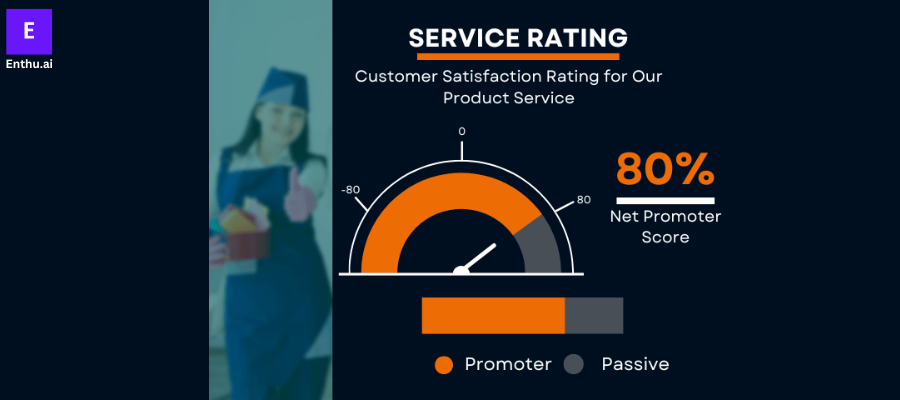
A bad NPS score is generally considered to be one that is negative or close to zero.
This means that a significant number of customers are not likely to recommend the company’s products or services to others, indicating low levels of customer loyalty and satisfaction.
An example of a “bad” Net Promoter Score (NPS) would be a score of -50.
This means that for every 100 customers surveyed, 50% would be considered “Detractors” (giving a score of 0-6 on the 0-10 scale).
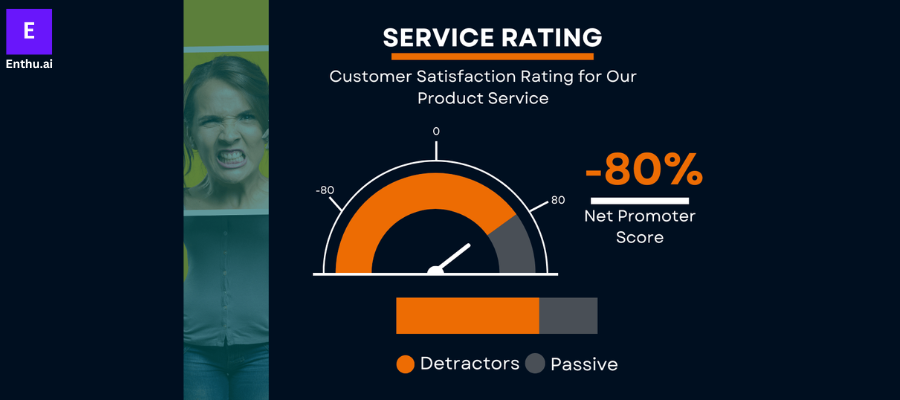
It’s important to note that an NPS score is relative, what can be considered as a bad score for one industry or company might be considered as good for another.
Therefore, companies often use NPS benchmarks to compare their results to those of their competitors.
F. 12-point checklist to an effective NPS improvement strategy
Making an efficacious strategy is a daunting task and it can be done effectively in the manner defined below:
- Structure a personalized NPS survey and white-label the form.
- Be punctual and set the time intervals and accountability for each task. NPS should not contain long conversations and interactions, till they are critically required.
- Do it the right way and use the proper mediums like SMS, text, or email according to the individual needs.
- Never ignore any details like follow-up & queries, you must find out the real reasons why it is happening and should solve the problem there and then
- Review the VOC dashboard & monitor sales performance metrics. Find the detractors, passives, and promoters.
- Satisfying detractors by positively interacting with them. Always probe into the details of loyal clients and admirers. Look into their feedback.
- Notice high CLV customers and prompt them to respond, and address them individually.
- Combine CSAT and CES with NPS to make it more effective. Integrate CSAT and CES (consumer electronics show) with NPS and even bridge the gaps which can delay the solution providing process.
- Converting slow responding customers to high responding customers, changing detractors into loyal customers, and remembering polite words can do a lot.
- Remind everyone that unresponsive customers should not be ignored at all.
- Monitor, review and check all the parameters that are strictly adhered to or not.
- The levels from top to bottom are to be indulged and should be aligned with the organizational goal, sometimes call centers are treated as completely separate units which is not a robust way to deal with them.
Conclusion
Net Promoter Score provides a simple, yet effective way to gauge the overall perception of a company and its products or services.
This is based on a single question that asks customers how likely they are to recommend a company to others.
Their are various of approaches to improve NPS such as streamlining customer support processes, offering personalized experiences, or implementing feedback loops.
By using NPS as a key performance indicator, companies can continuously strive to exceed customer expectations and provide exceptional experiences.
FAQs
1. How can we improve NPS score?
- Improve Customer Experience
- Act on Feedback
- Improve Communication
- Train Your Team
- Follow Up
- Deliver Value
2. How is a Net Promoter Score calculated?
NPS = (Number of Promoters) – (Number of Detractors) X 100
Number of Respondents
3. How to improve NPS as an agent?
- Listening Actively: Be sure to carefully listen to and address your customers’ comments and concerns.
- Personalizing Interactions: Tailor your responses to meet each client’s needs.
- Resolving Issues Promptly: Deal with issues and find prompt, efficient solutions
- Exceeding Expectations: Go above and beyond to provide exceptional service.
- Following Up: Follow up with clients to ensure their satisfaction after resolving their issues.
- Seeking Feedback: Collect feedback from clients about your services and use it to make improvements.

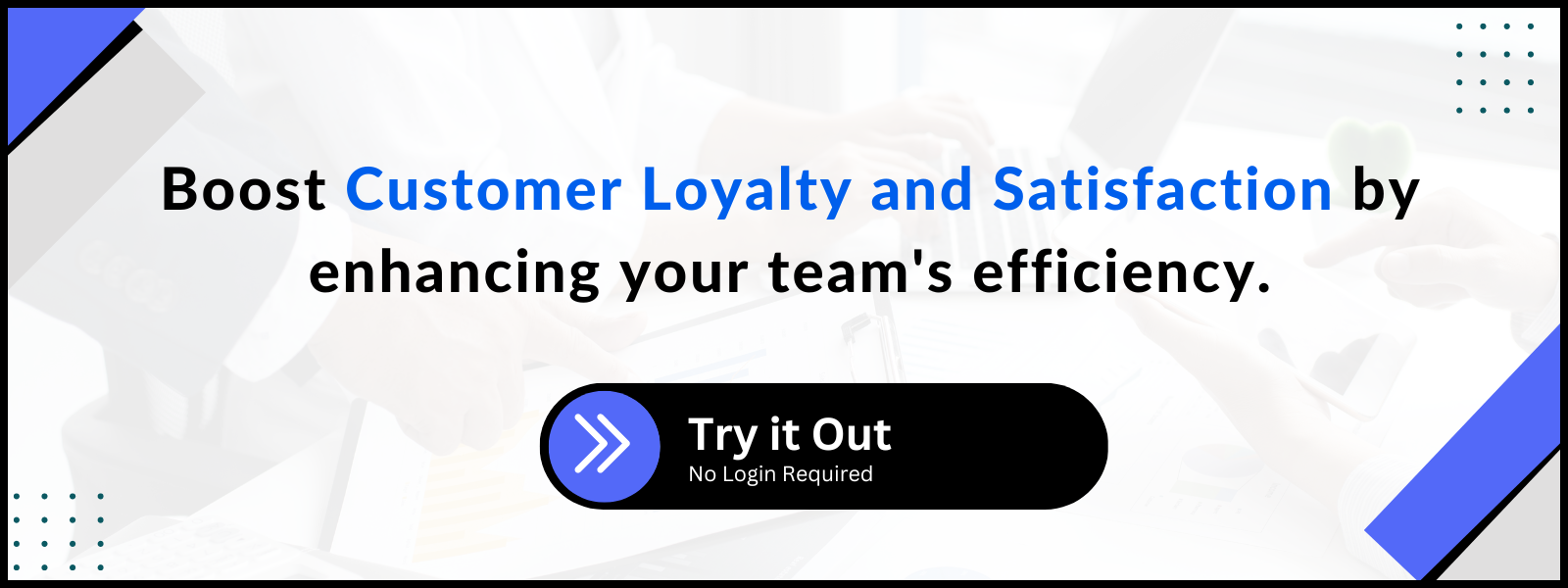


 On this page
On this page